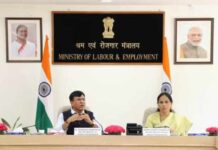
In a landmark decision, the Union Cabinet, chaired by Prime Minister Narendra Modi, has given the green light to the Unified Pension Scheme (UPS).
This scheme aims to revolutionize pension provisions for government employees, ensuring financial security and dignity in retirement.
What Is the Unified Pension Scheme?
The UPS is designed to replace the existing National Pension System (NPS) for government employees. Here are the essential points:
Assured Pensions: The UPS guarantees an assured pension, which is a significant departure from the market-linked NPS. Retirees with at least 25 years of service will receive 50% of their average basic pay from the last 12 months of employment.
Family Pensions: In case of an employee’s demise, the scheme provides an assured family pension equivalent to 60% of the employee’s pension.
Minimum Pension: The UPS ensures a minimum pension of ₹10,000 per month after a minimum of 10 years of service.
Also Watch: How Gen AI Transforms Compensation and Employee Benefits, Click Here
“PM Modi constituted a committee under the chairmanship of Cabinet Secretary TV Somanathan,’ Union Minister Ashwini Vaishnaw said.
He added, “This committee held more than 100 meetings with different organisations and nearly all the states. There’s a difference between how PM Modi works and the oppositions works.”
Ashwini said, “Unlike the opposition, PM Modi believes in holding extensive consultations. Following extensions consultations with everyone, including Reserve Bank of India and World Bank, the committee has recommended a Unified Pension Scheme.”
“Today, the Union Cabinet has approved this Unified Pension Scheme, and it will be implemented in the future,” he added.
How Is Unified Pension Scheme Different from NPS?
The UPS stands out from the NPS in several ways:
Fixed vs. Market-Linked: While the NPS relies on market performance, the UPS introduces a fixed assured pension structure. This stability is crucial for retirees.
Assured vs. Voluntary: NPS subscribers can choose to shift to the UPS. The latter offers greater certainty, especially for those nearing retirement.
Ashwini added, “Today the Union Cabinet has approved Unified Pension Scheme (UPS) for government employees providing for the assured pension…50% assured pension is the first pillar of the scheme…second pillar will be assured family pension…”
Also Watch: The Future of Jobs in BFSI Sector in FY25, Click Here
He said, “About 23 lakh employees of the central government would benefit from the Unified Pension Scheme (UPS)…There will be an option for the employees to opt between NPS and UPS.”
Eligibility and Implementation
The UPS will be effective from April 1, 2025. Those retiring up to March 31, 2025, with arrears are eligible. Approximately 23 lakh government employees stand to benefit from this scheme.
While announcing the details of the scheme, Union Minister Ashwini Vaishnaw said that the Centre constituted a committee that held 100 meetings with several top organizations, including the RBI and the World Bank.
This was done to make decisions on this scheme, which will benefit 23 lakh central government employees.
Reactions and Controversies
The UPS has sparked both enthusiasm and debate:
Support from BJP-Ruled States: Many states governed by the Bharatiya Janata Party (BJP) have welcomed the UPS, emphasizing its benefits for government employees.
Opposition and Reversion to Old Pension Scheme (OPS): Non-BJP-ruled states have expressed reservations. Some have even decided to revert to the OPS, which is non-contributory and differs significantly from the UPS.
PM Modi said the centre is “proud of the hard work of all government employees who contribute significantly to national progress”.
“The Unified Pension Scheme ensures dignity and financial security for government employees, aligning with our commitment to their well-being and a secure future,” he added.
Note: We are also on WhatsApp, LinkedIn, Google News, and YouTube, to get the latest news updates, Subscribe to our Channels. WhatsApp– Click Here, Google News– Click Here, YouTube – Click Here, and LinkedIn– Click Here.








